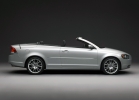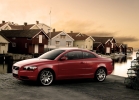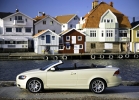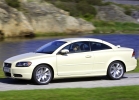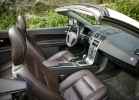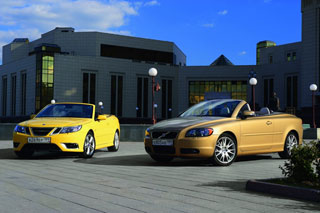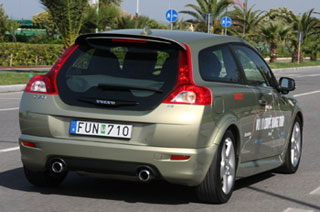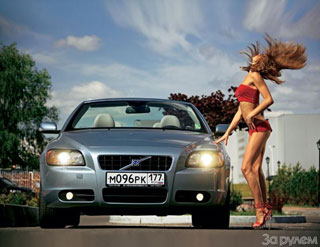VOLVO C70 test drive since 2005 compartment
Cabriolet
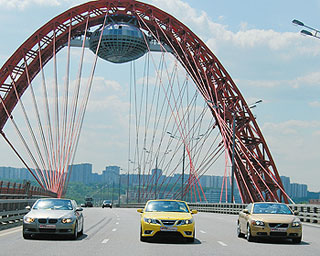
As in the old song is sung: in the summer it is better than in winter. And for convertibles this is doubly true. For it is given to reveal their true essence only in the warm season. And here it doesn’t matter what the roof saved you from the weather: the classic cloth, like the Saab 9-3, or the newfangled metal a la BMW 3 Series or Volvo C70. Down with her!
Skeptics will inevitably shout, recalling street dust and disappointing environmental monitoring data.
We agree: pushing in traffic jams, breathing in the aromas of trucks and other evil spirits, and there is no sugar in an ordinary machine.
What can we say about all the garbage winds of the convertible. But the fact of the matter is that the convertible car is unusual. I pressed the button and, after some 2030 seconds, is already reliably fenced off from the outer bustle. The process is fully automated. Moreover, unlike rivals, whose hard roofs can be folded, only in statics, say, at a traffic light, Saab allows you to operate with your soft top even in motion at speeds up to 30 km/h. A trifle, as they say, is nice. In any case, you do not have to restrain the stream, once again heating the mind outraged by the owners of less pathos vehicles.
Although, if it came to the manifestations of an exacerbated class consciousness, the cloth roof definitely loses iron. It is so easy to cut or burn it with a cigarette butt. On the other hand, the tank will not save the tank from the recent series of car arson in Moscow (remember the recent series of car arsons in Moscow).
Be that as it may, and the vast majority of automotive traders representing open models are now preferring precisely the hard top. And the point here is not even in anti -vandal resistance or all -weather (although such considerations have a place to be). Just a metal or plastic folding structure provides the body with greater stiffness. And this improves controllability and increases safety, practically endowing the convertible with the properties of the coupe. To designate such machines, the corresponding term compartment compartment, or by abbreviated SS, even appeared.
True, not all manufacturers use it. For example, contrary to the presence of a removed hard roof, the corresponding BMW model of the 3rd series should be called a convertible. The Bavarians emphasize this especially, because in the gamut of the threek there is a real compartment that more fully realizes the owner’s sports ambitions.
But in the company Volvo Car, on the contrary, they decided to abandon the body of the coupe in favor of a more universal coupe-battery: unlike the predecessor, the current C70 is offered only with a folding top. By the way, in the SAAB 9-3 line there is only an open two-door body (by the way, demonstrating very good hardness indicators for twisting). And the Scandinavians do not intend to part with a classic soft top.
Permanent customers, who, by and large, are based on the well -being of the company, appreciated it.
However, the descriptive prelude was somewhat dragged on. It's time to get acquainted with our heroes better, evaluating them to become, comfort and, of course, running opportunities. But first, still a little story.
The laurels of the oldest manufacturer of convertibles in our Trinity today should be awarded to the Bavarian Motor Plant. The history of open BMW has been drawn in 1967, when the 1600 Cabriolet model created in the Baur (Stuttgart) body (Stuttgart) on the basis of the same Bavarian compartment was born. The first real (with a completely open body) convertible BMW 3 Series debuted in 1985. It was also developed by BAUR specialists, however, like subsequent models, the car was already mainly produced by BMW forces. The previous third generation of open tremors lasted on the assembly line from 2000 to 2006, and last year our hero today replaced him (by the way, for the first time in history, a mild roof to a hard roof).
The children from Saab demolished the roof for quite some time: the predecessor of today's third series, model 900, first appeared in the body of the convertible back in 1986. In 1993, the first, and exactly a decade later, the second generation 9-3 Convertible debuted. Our guest is the fruit of a deep last year’s restyling of this very successful car (the next change of generations, apparently, is worth waiting in 2013). But jokes jokes, and the open Saab has become almost a business card and a powerful locomotive of the Swedish company in the main markets.
Their compatriots from Volvo, on the contrary, cannot be reproached for adherence to convertible. If you do not look too far into the past, counting from the OV4 JAKOB model of the 1927 model (and forget the two -seater R1900 class, released in 1955 in the amount of 67 copies), the company received modern experience in open cars only more than ten years ago. More precisely, in 1997, when, as part of a joint venture with a British engineering company, TWR stood on the conveyor of C70 compartment and a convertible top on its basis. The current second generation of the model, which debuted in 2005 in Frankfurt, was also developed in co -authorship. This time with Pininfarina.
The body of the Italians turned out to be wonderful. It seems that all family lines are obvious, but sharp lines are pleasantly smoothed. A cursory look almost does not distinguish a transformer from a regular compartment. (But this Swedes achieved this: as already mentioned, there is no real compartment in the line now.) To maintain proportions, the hard top had to be made from three sections: in folded form it is much more compact. The two-section design used by manufacturers of budgetary coupe-cabiolets is certainly easier. But too non -aesthetically, they look off the cabs shifted forward, protruding asses
It was possible to achieve comprehensive proportions and the Bavarians look very harmonious. And the raised roof even demonstrates the corporate bend of the hofmaster at the rear racks. In the asset of the hard top, you can write down good overview (compared to the soft roof, the glazing area increased by 30%), acoustic comfort and aerodynamic indicators comparable to the coupe.
However, the classic convertible Saab did not seem too noisy. And outwardly, he definitely does not lose to the rivals: an updated exterior with the emphasized wedge of the silhouette of the fierce and dynamic. Not to mention the color of the test machine, the combination of a lemon-yellow body and black top looks, you see, very advantageous.
The interior, however, could be more modern. Against the backdrop of rivals, the Saab salon looks somewhat archaic and poor (although maybe the matter is part in color: in the interior of the convertible, the black definitely loses to white). And with some ergonomic solutions like the ignition lock on the central tunnel, it would probably be worthwhile. But, excuse me, this is also a tribute to tradition.
Although by and large the driver of Saab has nothing to complain about. Driving here is quite comfortable. As, however, in two other convertibles. But the rear passengers will not envy. And may the 5-seater landing formula declared by dealers not mislead you (the reason for optimism, apparently, gives a lack of clear zoning of the space a la BMW)! In fact, you do not walk around here: a person in an inevitably in inevitably rests his knees into a hard back of the front chair. Perhaps the most convenient in the second row Volvo.
But be the back and more spacious, the convertible is still not suitable for the role of utilitarian family transport. If only because one suitcase is hardly placed in the trunk. Well, two are good. If there is no longer a roof. The destiny of this kind of machines is unhurried defile in evening boulevards, flowing into romantic trips to nature in the light of stars. For such walks, basic versions are quite suitable: BMW 320i (156 hp), a 2-liter 170-horsepower Saab or an economical Volvo C70 2.4 (140 hp).
However, you can quickly
May fans of the Swedish cars be forgiven, but the magnificent 306-horsepower BMW 335i motor in combination with a classic rear-wheel drive, of course, is out of competition. The car guarantees unforgettable pleasure.
But, as usual, you have to pay for it: first, more than two million rubles when buying, then for gasoline, which this biturbosver consumes a lot of active driving.
The lack of appetite and Swedes do not suffer. True, there are smaller horses here (under the hood of the top version of the convertible Saab there are 250 of them, and the Volvo C70 T5 only 230). But their character is also very perky. And the Scandinavian herds are noticeably cheaper than German.
Andrey Tsybulsky
Photo author: Armen Meetarjyan
Source: MKOMBILA magazine [June/2008]

